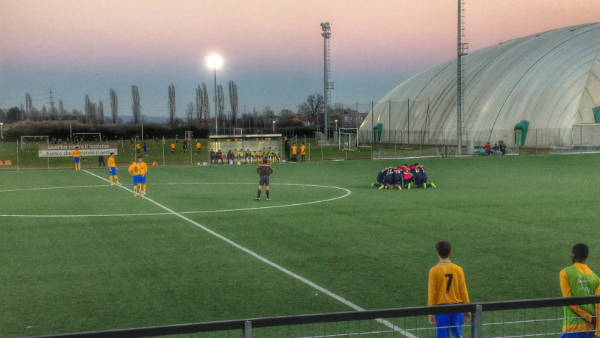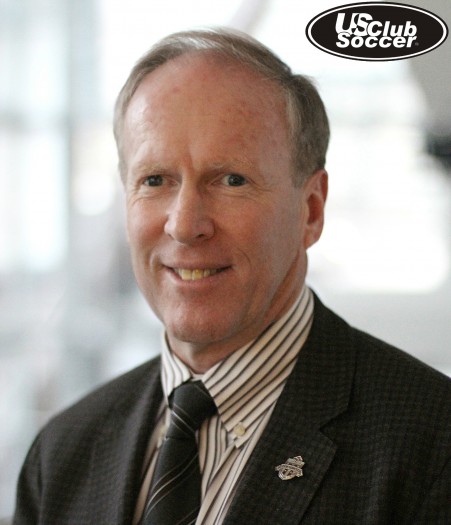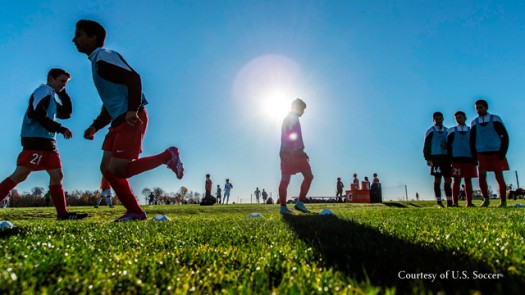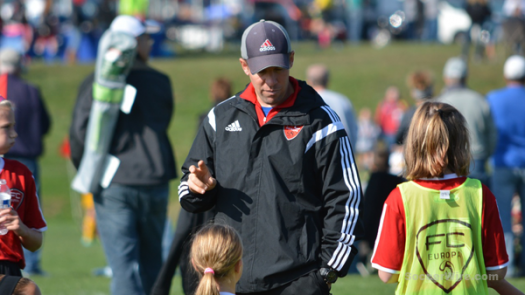SoccerWire Q&A: Kevin Payne on US Club Soccer’s new “Players First” program

Earlier this month US Club Soccer unveiled the “Players First” program, a new player development system “intended to transform the way youth soccer is viewed in the United States” by creating “a holistic club soccer experience for parents and players, emphasizing the development of each individual player to his/her full potential.”
Aided by partnerships with Nike, La Liga (Spain’s top-flight professional league), Beast Mode Soccer, SoccerPrep and other industry specialists, US Club Soccer – the club-centric organization formed in 2001 by a breakaway faction from US Youth Soccer – wants to help its members upgrade both the tone and substance of the youth soccer experience as we know it in the United States.
+READ: US Club Soccer unveils new “Players First” youth development platform
Clearly, the organization is thinking big, even by the ambitious standards of their short history. So SoccerWire.com eagerly accepted an opportunity to have an in-depth conversation on “Players First” with Kevin Payne, the longtime MLS executive who was named US Club Soccer CEO last winter.
Our chat ranged well beyond the scope of this particular topic, though, as Payne – who’s worked in various levels of North American soccer for decades – shared his thoughts on an array of prominent player development issues. This is the first in a multi-part series that resulted from our discussion.
SoccerWire: Can you shed light on the roots of “Players First”? Was this plan created by your member clubs?
Kevin Payne: I think that in terms of a coherent strategy, particularly the notion of creating a branded soccer experience, that came really from our national office. But it came as a result of many, many, many conversations that I’ve had and US Club Soccer had long before I got here, going back eight or 10 years with people around the country who I respect and who run good clubs.
 We are trying to be realistic about what the landscape is like in youth soccer. We don’t want to just preach at clubs and tell them, ‘You’re doing it wrong, we know how you should be doing it.’ We’re trying to create a framework that clubs can adopt and a company with a lot of value-added services that they can take advantage of, to help them do a better job every day and become more successful businesses.
We are trying to be realistic about what the landscape is like in youth soccer. We don’t want to just preach at clubs and tell them, ‘You’re doing it wrong, we know how you should be doing it.’ We’re trying to create a framework that clubs can adopt and a company with a lot of value-added services that they can take advantage of, to help them do a better job every day and become more successful businesses.
SW: Is US Club Soccer looking to lay out the definitive development pathway for players that want to become professionals and internationals here?
KP: We’re definitely not being that specific. US Club Soccer has traditionally had a much higher percentage of its membership on competitive clubs. We’re about 75 to 80 percent competitive players, where the traditional state associations tend to be the reverse of that. But we are not only focused on players who think that they have a very high level of soccer in their future. The whole principle of this is that we want clubs to create the best possible environment for every player. Because particularly at the younger ages, no one knows which player is going to become the elite player.
At the ages of 10, 11, 12, kids’ developmental age can vary as much as plus or minus four years from their chronological age. So you could have a 12-year-old kid and they might be developmentally closer to a 16-year-old, or they might be developmentally – especially physically – closer to an 8-year-old. So when the sport is losing 70 percent of its participants by the age of 12, there’s no way that anybody can tell you they’re not worried about that because that 70 percent is a cohort with no chance of becoming elite players.
“We think it’s an absolutely critical element of player development in the U.S. to keep a much higher percentage of our soccer population involved in the game longer.”
The fact is, within that 70 percent there undoubtedly are players who could’ve become elite players. They just never got the chance, because they were subjected to such an intense and unpleasant experience, largely shaped by a very outcome-driven culture that they just said, ‘this isn’t fun any more, so I’m leaving.’
Those kids and the people around them never got the chance to figure out whether maybe they could be a serious player. It’s way, way too early to be expecting young players to exhibit the qualities necessary … We think it’s an absolutely critical element of player development in the U.S. to keep a much higher percentage of our soccer population involved in the game longer.
So this isn’t really aimed at simply producing more players who might end up playing someday in the academy and ultimately, professionally or in the national team. This is about creating an environment which nurtures every single player and encourages them to become the best player they can be, whatever level that is.
SW: We tend to think that soccer is on a path of constant growth at all levels in this country, but that’s not necessarily the case, especially in the youth game.
KP: We’re actually not growing. The universe of registered players has actually remained pretty flat. But the percentage of our players that leave the sport at way too early an age is among the highest – I think we’re about the same as baseball. In baseball it largely happens because there’s a pretty radical change after the age of 12 in baseball, because now you go to 90-foot basepaths and a 60-foot mound, and the game is different – for the kids who haven’t matured physically at age 12, baseball is not very fun.
 In our case, it’s kids being driven out of the game because we have created a culture where there is so much focus on winning at all costs that it isn’t fun. And we know that the No. 1 reason kids play sports is to have fun. I think a lot of the studies that have gone out, Dan Coyle [author of “The Talent Code”] and a number of others, have really been misunderstood by people and they’ve been taken out of context … [The idea that] every kid, if they just practice 10,000 hours, can become Tiger Woods, and that’s just not the way it works.
In our case, it’s kids being driven out of the game because we have created a culture where there is so much focus on winning at all costs that it isn’t fun. And we know that the No. 1 reason kids play sports is to have fun. I think a lot of the studies that have gone out, Dan Coyle [author of “The Talent Code”] and a number of others, have really been misunderstood by people and they’ve been taken out of context … [The idea that] every kid, if they just practice 10,000 hours, can become Tiger Woods, and that’s just not the way it works.
There is a ton of research out there on why kids play sports and why they leave sports. And it all points to the central factor of fun. There’s a lot of other reasons why they like to play sports: The companionship of their friends, being members of a team, feeling worthy, the gear, the uniform, the gym bag. And kids would rather play regularly on a losing team than sit the bench on a winning team.
“When you spend time with people who are in the business of coaching coaches overseas, it’s pretty apparent that they are considerably ahead of us.”
So we just need to create a culture that is less about the gratification of coaches and parents – who are in a sort of symbiotic, but not particularly constructive, relationship with regards to winning – and start focusing more on the players. All the players. So that’s why the program is called Players First. We’re trying to get everybody to think first, ‘Is this the best decision for the players?’ And if it’s not, then it can’t be the right decision.
SW: Where does the wider quality of coaching fit in here? We hear a rising chorus of those who say the depth and breadth of U.S. coaching must diversify and improve just as the player pool has in recent decades.
KP: The French say it, the Spanish say it, the Germans say it, the Dutch say it – they all say it: if you want better players, you need to have better coaches. And if you want better coaches, you need to create better environments for coach instruction. So that’s a central element of this as well. We’re not responsible for licensing; that’s the U.S. Soccer Federation’s job – although they have empowered organizations like ours to begin to instruct unlicensed coaches in the lower-level coaching licenses to get them on a pathway to learn more.
 We are trying to provide a lot of resources for currently-licensed coaches to continue their education, to learn more outside of the licensing structure. When you spend time with people who are in the business of coaching coaches overseas, or even when you spend time with higher-level development coaches overseas, it’s pretty apparent that they are considerably ahead of us. They’ve been doing it longer, there’s more at stake for them, there’s a clearer understanding of what they’re trying to accomplish and they have a much more comprehensive approach. It’s not even close.
We are trying to provide a lot of resources for currently-licensed coaches to continue their education, to learn more outside of the licensing structure. When you spend time with people who are in the business of coaching coaches overseas, or even when you spend time with higher-level development coaches overseas, it’s pretty apparent that they are considerably ahead of us. They’ve been doing it longer, there’s more at stake for them, there’s a clearer understanding of what they’re trying to accomplish and they have a much more comprehensive approach. It’s not even close.
La Liga demonstrated to us last weekend an entire system of periodization for youth teams that was beyond what most of our MLS teams would do. It’s just much more of a true profession there, and that’s just because we’re newer at it, we haven’t been doing it as long. It’s not because we’re incapable, because we certainly are capable. And we want to give our coaches as many opportunities as possible to learn from what is being done in other countries, so they can take elements of that and incorporate it into how they do things.
We can’t just adopt the La Liga approach to developing players, or the French approach, or the Dutch or anybody else. We have to create our own style that’s appropriate for the United States. But there are many things that they do that we can learn from, and that we can adapt for use here. And we have to do that, because we’re not producing high-quality players at anywhere near [capacity].
We have never produced, on the men’s side, a truly world-class field player. We’ve produced some very good players that are very, very high-level: Claudio Reyna, Landon Donovan. But until we regularly produce field players who are starting for Real Madrid or Barcelona or Bayern Munich or Manchester United or Manchester City, then we’re not at the same level as these other countries.
Editor’s note: Check back when our conversation with Kevin Payne continues next week…











